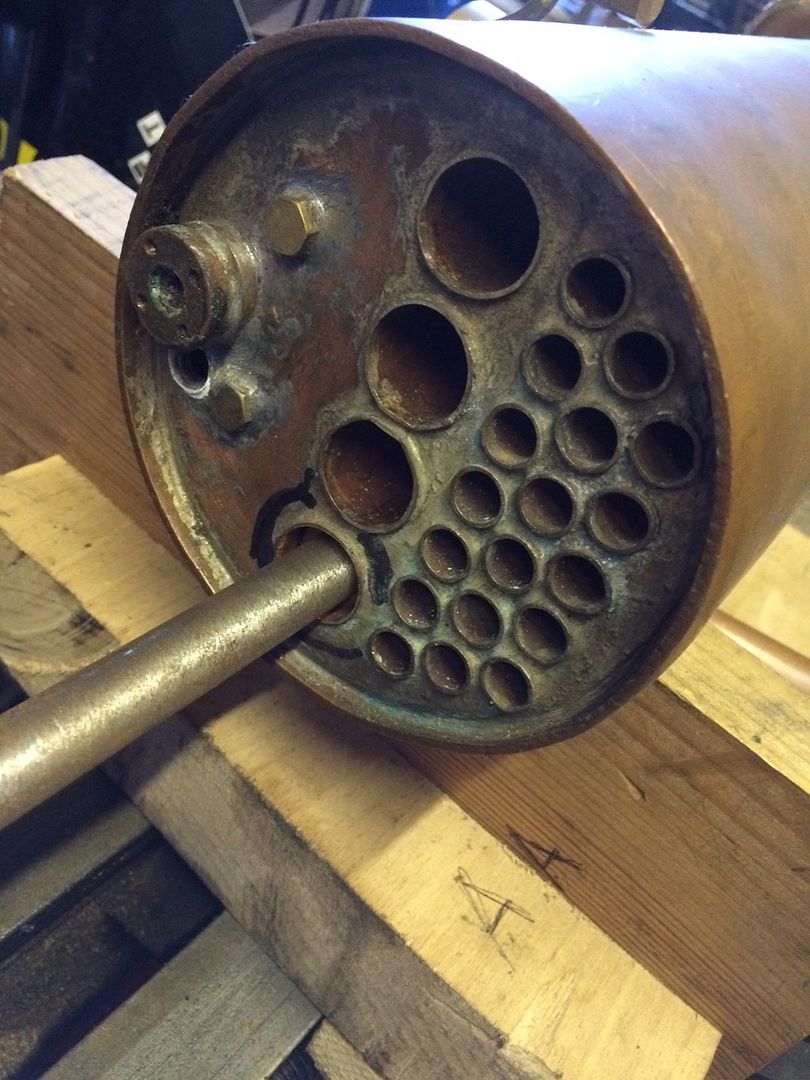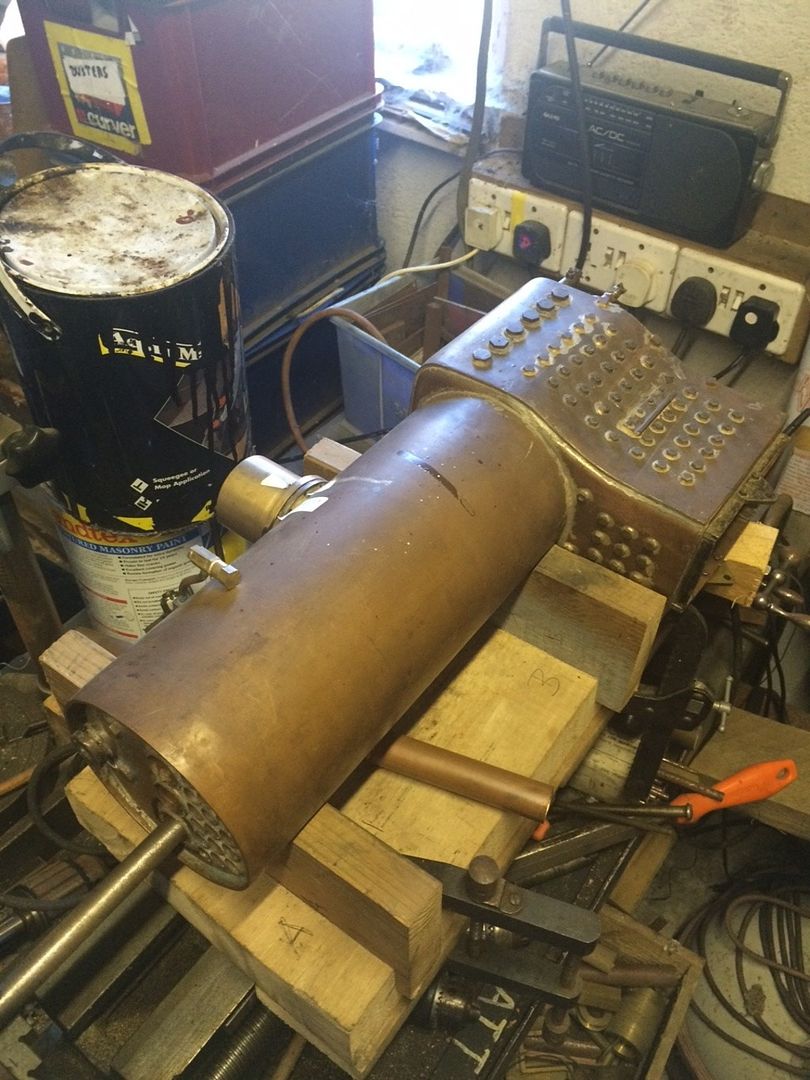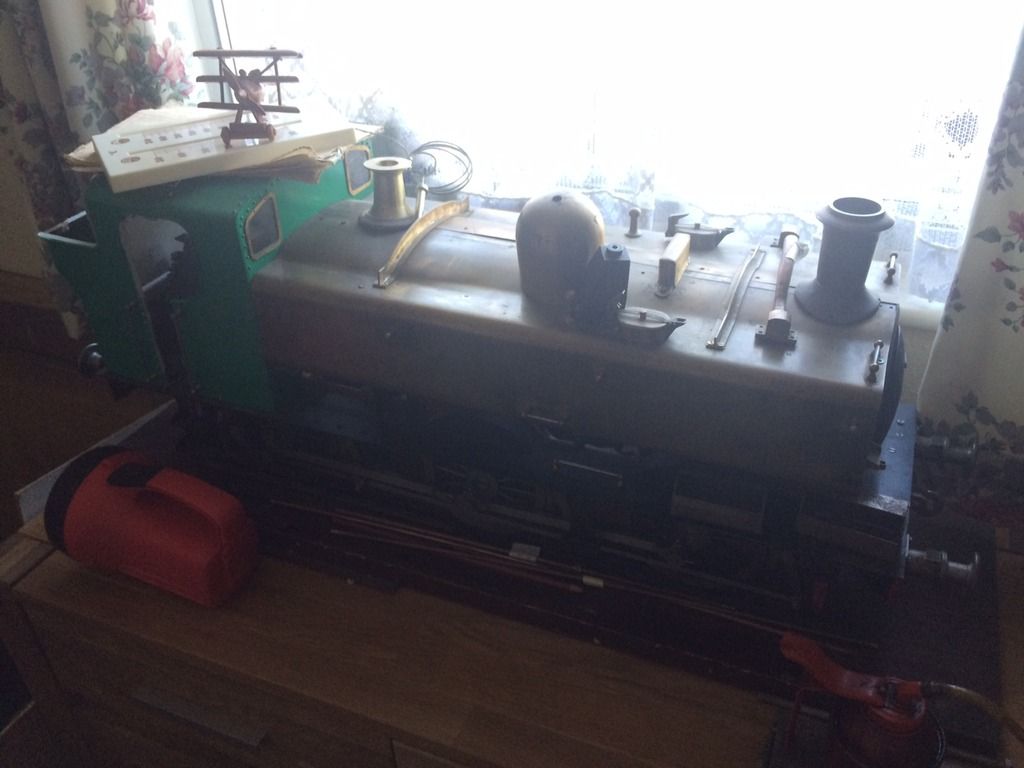|
|
Post by Doug on Aug 2, 2015 16:13:26 GMT
ok bit of a loaded odd question I have been asked if it is possible to fix a leaking tube in a boiler or is it scrap once it's soldered up and leaks. the reason it's a loaded question is that the boiler builder has made the boiler without having it checked during construction so it's probably scrap anyway, and he second point is that if the tube is split before it has been pressure tested so he has probably used a seam welded tube not the correct drawn seamless type. so the question is more of an academic type "what if" bit of shame really as he looks to have done a reasonable job of the boiler copper although the solder looks decidedly not like silver solder.   |
|
pault
Elder Statesman
  
Posts: 1,500
|
Post by pault on Aug 2, 2015 16:36:00 GMT
the silver solder on the tube plate looks overheated to me, between that, the seemed tube and the fact that it has not had staged inspections I would suggest it is scrap
|
|
jma1009
Elder Statesman
  
Posts: 5,918
|
Post by jma1009 on Aug 2, 2015 20:50:29 GMT
hi paul,
looks like an LBSC Pansy boiler to me.
i would suggest your friend asks john ellis very nicely to have a look to see if anything can be salvaged (john lives not far from you). so long as no soft solder/comsol has been used it is possible the superheater flue tubes can be cut out and new ones silver soldered in with easyflo 2 and someone like john very experienced at using oxy acetelyne on miniature boilers. unfortunately the LBSC designed throatplate designed for sifbronze welding is liable to crack open during this process. otherwise i agree with pault.
cheers,
julian
|
|
|
|
Post by Doug on Aug 2, 2015 21:06:42 GMT
hi paul, looks like an LBSC Pansy boiler to me. i would suggest your friend asks john ellis very nicely to have a look to see if anything can be salvaged (john lives not far from you). so long as no soft solder/comsol has been used it is possible the superheater flue tubes can be cut out and new ones silver soldered in with easyflo 2 and someone like john very experienced at using oxy acetelyne on miniature boilers. unfortunately the LBSC designed throatplate designed for sifbronze welding is liable to crack open during this process. otherwise i agree with pault. cheers, julian Thanks Julian it is indeed a Pansy boiler I will speak to the guys mate tomorrow and get more information from him but I have already suggested that the boiler is unfit for public use. I certainly would not be happy with it running at our club on a public running day with the issues it seems to have, it kinda highlights the good boiler test regiments that we have in the UK. My boiler inspector wants to see my boiler 4-5 times at least during construction and I totally agree with him why. Scary stuff when it goes wrong. ta Doug |
|
jma1009
Elder Statesman
  
Posts: 5,918
|
Post by jma1009 on Aug 2, 2015 21:59:41 GMT
hi doug,
many apologies got it my adled head juliet2 (paul) had started this thread! oops!
john ellis is a bit of a way from you unlike paul.
it is surprising what happens in some boiler construction jobs and it just goes to show why you ought to buy the correct material from regognised suppliers. ive seen tube perforate and laminate from doubtful sources, and a while back had an awful row with some guy on another forum who thought it was ok to buy his boiler flue tube material from B&Q.
in years gone by it was not unknown for boiler tubes on a copper boiler to be replaced. a very old friend of mine even had his firebox on a 5"g loco used on a commercial public railway cut in half by Charlie Kennion then silver soldered back together. but these skills are probably now a thing of the past.
cheers,
julian
|
|
|
|
Post by GWR 101 on Aug 2, 2015 22:15:28 GMT
Hi Doug and Julian, no problem re being mentioned and you are correct about John being nearer to me. He actually made my Juliet boiler, and a grand job he made of it. Regards Paul
|
|
|
|
Post by runner42 on Aug 2, 2015 22:17:57 GMT
How about closing off both ends with a appropriate plug silver soldered in place? The superheater would need to be modified to a three element type. This of course needs to be discussed with the BI.
Brian |
|
jma1009
Elder Statesman
  
Posts: 5,918
|
Post by jma1009 on Aug 2, 2015 22:32:00 GMT
hi brian,
whilst at face value your suggestion is sensible (though would cause the boiler to be less effective), it begs the question whether the other 3 superheater flues are made of the same stuff and therefore also liable to laminate or split.
i would not like to be sat behind driving a loco that suddenly had a main boiler tube split/fail, or be sat at a station with the public peering into the cab watching me put coal on. the reason we have quite a stringent boiler code including inspection during construction and receipts for materials should be obvious and from doug's posted example shows the need for such vigilence.
cheers,
julian
|
|
|
|
Post by steamcoal on Aug 3, 2015 0:04:18 GMT
Julian.
This is what I was getting at with suggesting a basic do's and don't list which can be given to prospective boiler builders by clubs. Not everyone is good at listening and sticking to the rules but if it is put in black and white without all the prefirrial technical stuff first up some very expensive mistakes could be avoided.
It only takes one false step and the whole project is scrap.
How many golden rule have been broken on this one?
Design ?
Materials ?
Workmanship ?
Supervision ?
Testing ?
Rest my case, Sir.
|
|
|
|
Post by runner42 on Aug 3, 2015 7:37:30 GMT
Hi Julian,
this is somewhat speculative on my part but I am amazed that copper pipe can be made other than seamless, it would be more expensive to weld a joint instead of drawing it through a die. The AMBSC Code Part 1 doesn't address seam welded copper pipe, my assumption is that either it doesn't exist or that both seamless and seam welded copper tube is acceptable. I have looked at the photograph of the smokebox tube plate and it appears that the superheater tubes are thin walled and that fracture is due to overheating of the smokebox tubeplate causing unequal heating of the flues/tubes and barrel, probably due to prematurely silver soldering the smokebox tubeplate. It appears a competently built boiler so I am saddened by the fact that it destined for the scrap bin, without attempting to ameliorate the leaking flue problem.
Brian
PS I can see an advantage in having seam welded copper tube over seamless but this is would be applicable to large diameter copper tube with a relatively small wall thickness, where the cost of large diameter dies exceed the cost of welding. |
|
|
|
Post by Doug on Aug 3, 2015 8:05:24 GMT
Hi Julian,
this is somewhat speculative on my part but I am amazed that copper pipe can be made other than seamless, it would be more expensive to weld a joint instead of drawing it through a die. The AMBSC Code Part 1 doesn't address seam welded copper pipe, my assumption is that either it doesn't exist or that both seamless and seam welded copper tube is acceptable. I have looked at the photograph of the smokebox tube plate and it appears that the superheater tubes are thin walled and that fracture is due to overheating of the smokebox tubeplate causing unequal heating of the flues/tubes and barrel, probably due to prematurely silver soldering the smokebox tubeplate. It appears a competently built boiler so I am saddened by the fact that it destined for the scrap bin, without attempting to ameliorate the leaking flue problem.
Brian
PS I can see an advantage in having seam welded copper tube over seamless but this is would be applicable to large diameter copper tube with a relatively small wall thickness, where the cost of large diameter dies exceed the cost of welding. Hi Brian i am not a boiler inspector but the bigger problem on this boiler other than the leaking tube is that it is an un inspected build, the problem with this is the various internals that are safety critical are invisible once it has been built for instance what if the crown stays are very poorly soldered it may well pass a pressure test only to fail in a couple of years after a few heat cycles there are other issues too. It would require alot of faith by any boiler inspector to say this is a safe design and build when you can only see a part of it. yes the tube could be fixed it would be a tricky repair but what then? would you like to have 2 gallons of very hot water between your legs that could explode at any moment. I put my faith in the boiler inspection regime to find any flaws in the build as it is being made, so to me sad as it is, it has been made incorectly and should for safety's sake be consigned to the scrap bin. you are probably dead right about the tube i have only guessed at it being a seamed tube as it has split before pressure testing but your description of the failure mankes perfect sence. all the best Doug |
|
steam4ian
Elder Statesman
   One good turn deserves another
One good turn deserves another
Posts: 2,069
|
Post by steam4ian on Aug 3, 2015 9:53:44 GMT
Doug.
I suggest your friend get a boroscope camera set up from Jaycar, Maplins probably have them as well. Through the dome and regulator bushes you can get a good look at the firebox crown. I assume it uses girder stays not rod stays on the crown which is a bit of a disadvantage but the camera should show enough for a go no go test.
The tubes and flues do look thin and the solder is very grey. However the outward appearance of the workmanship around the firebox appears very good.
I would spend a little more before consigning it to scrap.
Regards
Ian
|
|
mbrown
Elder Statesman
  
Posts: 1,790
Member is Online
|
Post by mbrown on Aug 3, 2015 13:54:23 GMT
Hi Julian,
this is somewhat speculative on my part but I am amazed that copper pipe can be made other than seamless, it would be more expensive to weld a joint instead of drawing it through a die. The AMBSC Code Part 1 doesn't address seam welded copper pipe, my assumption is that either it doesn't exist or that both seamless and seam welded copper tube is acceptable. I have looked at the photograph of the smokebox tube plate and it appears that the superheater tubes are thin walled and that fracture is due to overheating of the smokebox tubeplate causing unequal heating of the flues/tubes and barrel, probably due to prematurely silver soldering the smokebox tubeplate. It appears a competently built boiler so I am saddened by the fact that it destined for the scrap bin, without attempting to ameliorate the leaking flue problem.
Brian
PS I can see an advantage in having seam welded copper tube over seamless but this is would be applicable to large diameter copper tube with a relatively small wall thickness, where the cost of large diameter dies exceed the cost of welding. Small diameter copper tube definitely can split lengthways... as happened to the cold water pipe in the bathroom of my previous house.... about a six inch split longitudinally let out rather a lot of water with deleterious effects on the décor of the living room below. It was a new-build house and we'd lived there only a year or two - it had been built by a local man who, it turned out, sourced most of his materials off the back of various lorries. On the plumber's advice, we had most of the pressurised pipe work replaced "just in case". The piping was juts about the diameter and gauge you might use for a superheater flue ... the moral is check the provenance of all boiler materials.... Malcolm |
|
|
|
Post by Doug on Aug 3, 2015 17:28:41 GMT
Sadly the owner/builder is 90 years old he has been building his Pansy for years but now has Alzheimer's he lives in the Bristol area and its his nephews that are trying to get it finished for him one of which I know and has been asking the questions. I have advised that the best way to get this resolved is to try and get one professionally built and also told them that this may only be the start of the problems as I have well learnt, having a "model" does not mean it will work. I have passed on the above advice and if I hear any feed back from him I will post it on here. Many thanks, Doug  |
|
|
|
Post by runner42 on Aug 3, 2015 23:18:44 GMT
This is just shooting the breeze. There is a large number of locomotive builders who have made their project a life long exercise and presumably like the old bloke mentioned here built their boilers before the regulations covering stage inspections existed, so are these somewhat unfortunate individuals unable to get their boilers to pass muster? I thought that the regulations addressed these legacy issues and made provision for such instances. On the subject of the borescope camera, yes this is an option for the BI to see the crown stays silver soldering and although it requires a 10mm opening it is certainly feasible to push it through the smokebox tubeplate.
Brian |
|
|
|
Post by Doug on Aug 4, 2015 5:43:05 GMT
Thanks Brian I did tell my friend to get in touch with a boiler inspector as it really hangs on the inspector it would be totally his responsibility so I personally doubt that anyone would say yest to a retrospective inspection, but it has to be the first port of call. It's not even worth repairing before an inspector looks at it.
it is a good point about the older boilers tho. My butch was finished in 1962 but the boiler cert/first test was 1981. So it's obviously possible.
|
|
|
|
Post by runner42 on Aug 4, 2015 22:46:35 GMT
Hi Julian,
this is somewhat speculative on my part but I am amazed that copper pipe can be made other than seamless, it would be more expensive to weld a joint instead of drawing it through a die. The AMBSC Code Part 1 doesn't address seam welded copper pipe, my assumption is that either it doesn't exist or that both seamless and seam welded copper tube is acceptable. I would like to make a correction on my incautious statement that the AMBSC Code Part 1 doesn't address seam welded copper tube. It does at para 2.2 a list of acceptable copper materials and included is AS 1572-1985 Copper and Copper Alloys - Seamless tubing for Engineering Purposes and AS 1432 - 1990 Seamless Copper Tube for Plumbing, Gas fitting and Drainage Purposes. Since both covers the use of seamless copper tube, thereby by default making the use of other than seamless copper tube unacceptable.
Brian
|
|